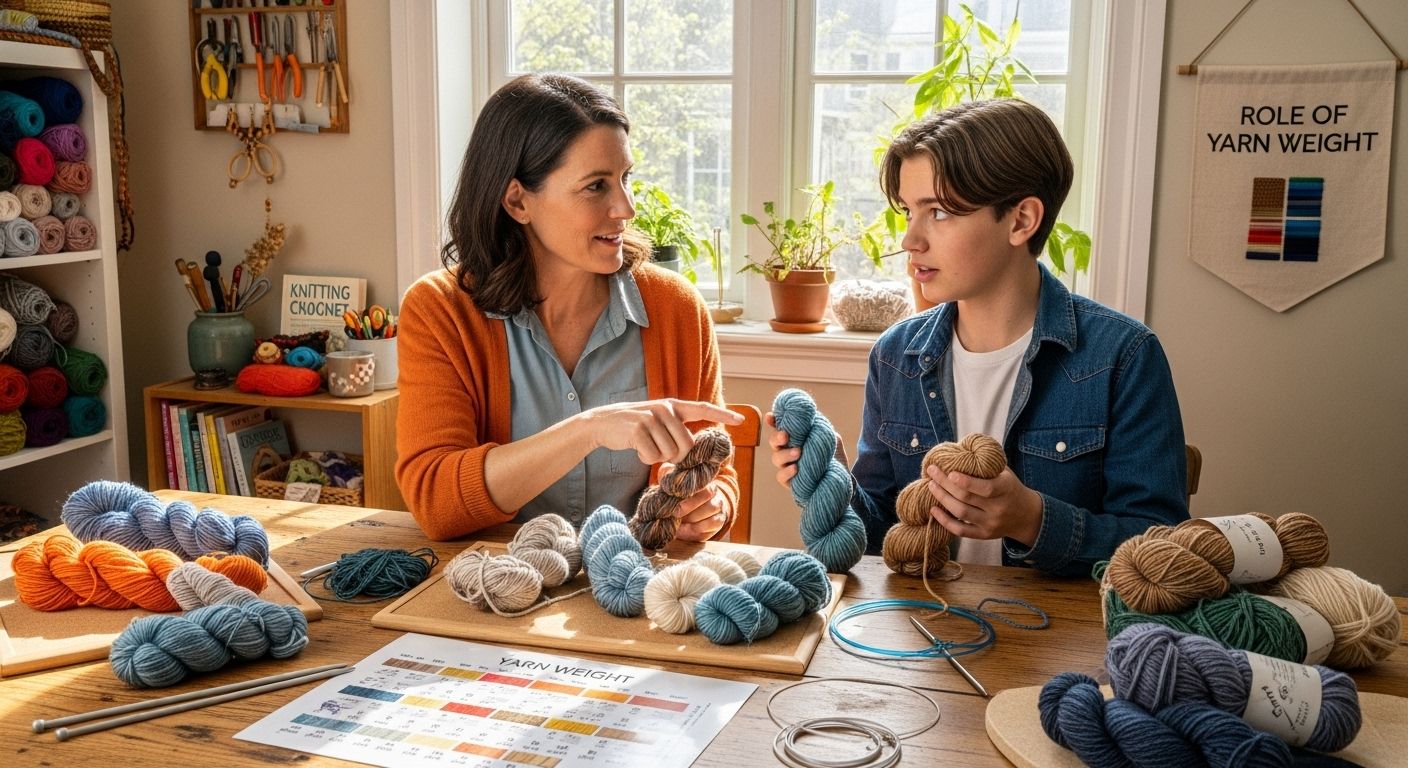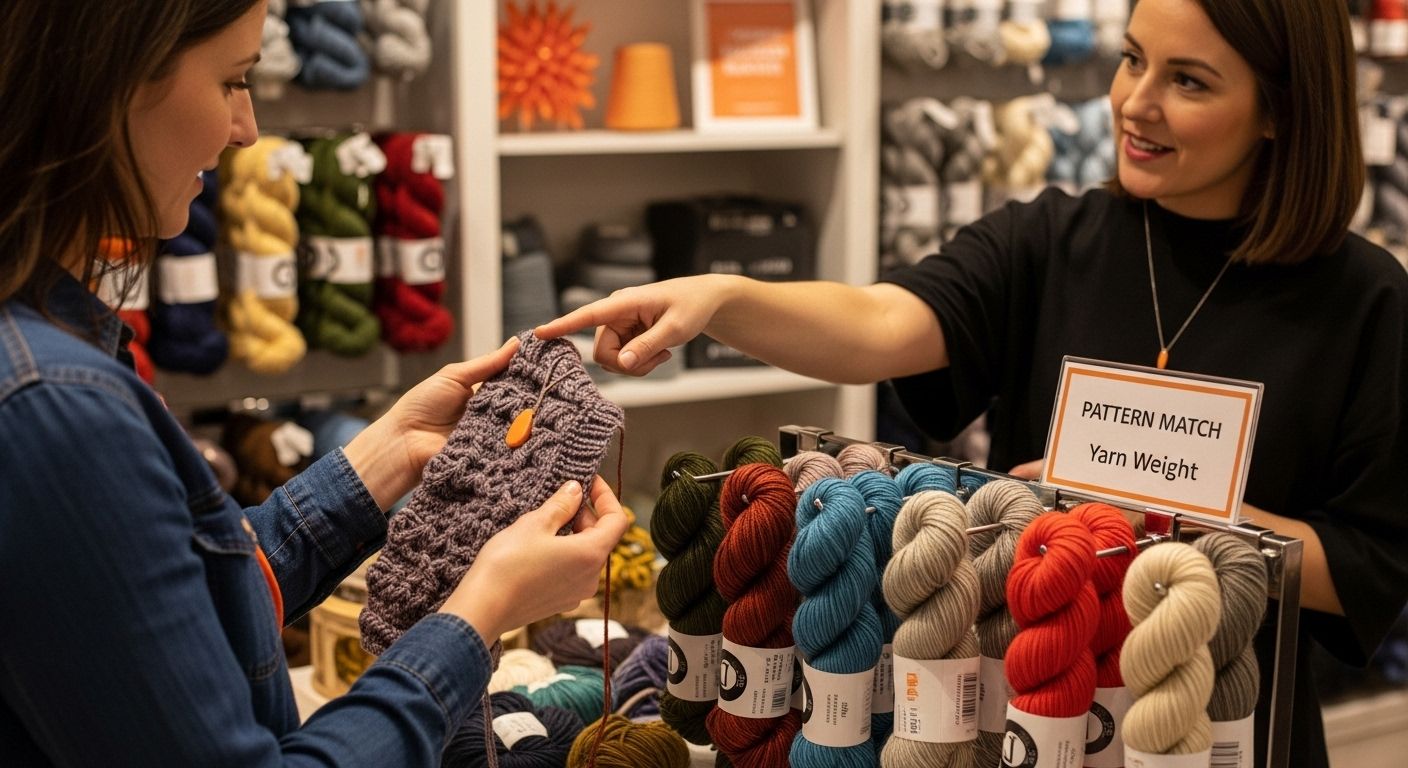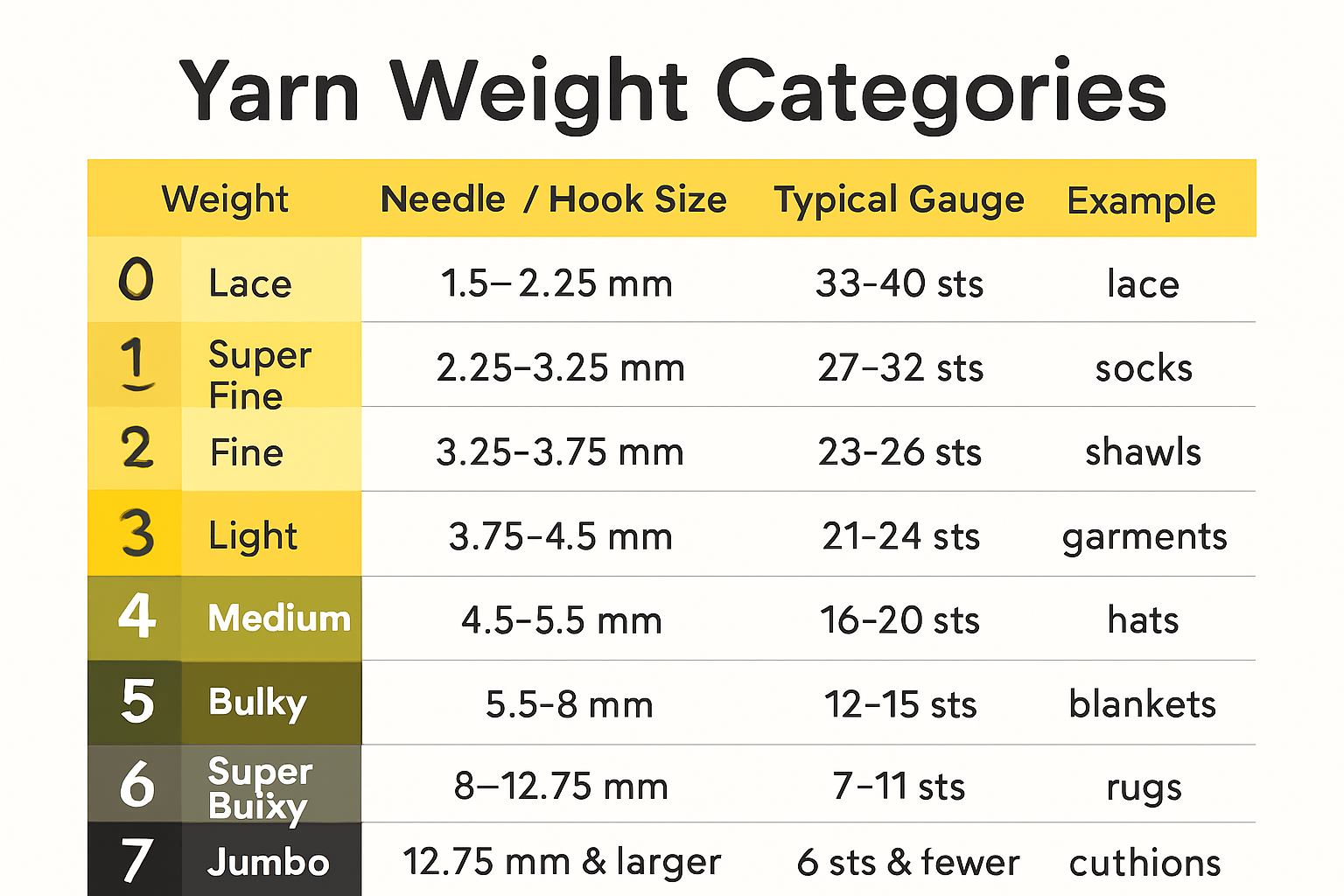
Understanding the Role of Yarn Weight in Crafting

Yarn weight might sound technical but it completely transforms every knitting or crochet project. Some crafters are shocked when they realize the Craft Yarn Council outlines eight separate weight categories, ranging from lace to jumbo. It turns out this system is not about measuring with a scale but about the way every strand shapes how your finished work looks, feels, and even lasts.
Table of Contents
- Defining Yarn Weight: What Does It Mean?
- Why Yarn Weight Matters: Impact On Projects
- How Yarn Weight Influences Texture And Gauge
- Matching Yarn Weight To Patterns: Key Considerations
- Exploring Yarn Weight System: Standards And Categories
Quick Summary
| Takeaway | Explanation |
|---|---|
| Understand yarn weight categories | Familiarize yourself with categories from 0 (Lace) to 7 (Jumbo) to choose suitable yarn for projects. |
| Use wraps per inch (WPI) technique | Measure yarn thickness by wrapping it around an inch to determine its weight when labels are unclear. |
| Select yarn based on project requirements | Match yarn weight to project needs to ensure the finished item meets design and functional expectations. |
| Consider gauge for perfect fit | Check that your gauge aligns with pattern specifications to achieve accuracy in size and appearance. |
| Evaluate factors affecting texture and durability | Assess thickness, fiber content, and plying methods to anticipate how yarn characteristics influence the final fabric. |
Defining Yarn Weight: What Does It Mean?
Yarn weight is a fundamental characteristic that describes the thickness of yarn, directly influencing the texture, appearance, and final outcome of crafting projects. Unlike literal weight measured in ounces or grams, yarn weight refers to the diameter or thickness of the yarn strand. This critical measurement determines how your crafted item will look, feel, and perform.
Understanding the Yarn Weight Classification System
The Craft Yarn Council has established a standardized system that categorizes yarn into specific weight ranges, making it easier for crafters to select appropriate materials. Learn more about yarn weight classifications to understand how these categories impact your crafting.
The standard yarn weight system includes eight primary categories, ranging from 0 (Lace) to 7 (Jumbo). Each category provides crucial information about recommended needle and hook sizes, typical gauge ranges, and expected stitch appearances. The weight categories help crafters make informed decisions about yarn selection based on their project requirements.
Key Factors in Determining Yarn Weight
Multiple techniques can help identify yarn weight, with wraps per inch (WPI) being a primary method. WPI involves wrapping yarn around a consistent circumference and measuring how many times it can be wrapped within one inch. This technique is particularly useful when yarn labels are missing or unclear.
Other important factors in determining yarn weight include:
- Fiber content and composition
- Spinning technique
- Number of plies in the yarn
- Recommended needle or hook size
While understanding different yarn weights might seem complex, mastering these classifications empowers crafters to select the right materials for their specific projects, ensuring optimal results in knitting, crocheting, and other textile crafts.
Why Yarn Weight Matters: Impact on Projects
Choosing the right yarn weight is critical for crafting success, as it profoundly influences the final appearance, texture, and functionality of your project. The weight of yarn determines not just the visual aesthetic but also the structural integrity and performance of knitted or crocheted items.
Structural and Visual Implications of Yarn Weight
Yarn weight directly impacts the drape, warmth, and overall characteristics of a finished piece. Lighter weight yarns create delicate, intricate fabrics with fine details, while heavier weights produce robust, substantial textiles. Learn more about selecting the right yarn weight to match your project requirements.
According to research from the Journal of Textile Science and Technology, variations in yarn count and structure significantly affect mechanical properties such as fabric density, shrinkage, and durability. This scientific insight underscores the importance of carefully selecting yarn weight based on your specific crafting goals.
Key Project Considerations When Selecting Yarn Weight
Multiple factors influence how yarn weight impacts your project:
- Garment Drape: Lighter weights create fluid, elegant drapes
- Thermal Insulation: Heavier weights provide more warmth
- Stitch Definition: Different weights reveal stitch patterns differently
- Project Durability: Yarn weight affects fabric strength and longevity
Understanding these nuanced impacts allows crafters to make informed decisions, ensuring their projects not only look beautiful but also perform exceptionally well under various conditions.
Here is a table breaking down the main factors that influence how yarn weight impacts project characteristics, making it easier to compare their effects side by side:
| Factor | Impact on Project | Example/Description |
|---|---|---|
| Garment Drape | Light weights create fluid drape | Lace yarns for shawls |
| Thermal Insulation | Heavy weights provide more warmth | Bulky yarn for winter hats |
| Stitch Definition | Weight alters stitch visibility | Lighter yarns show detailed stitch patterns |
| Project Durability | Affects long-term wear | Worsted for sturdy blankets vs. lace for delicacy |
| Fabric Density | Determines thickness and feel | Super bulky produces dense, cushioned fabric |
How Yarn Weight Influences Texture and Gauge
Yarn weight plays a transformative role in determining the texture and gauge of crafted fabrics, serving as a critical factor that influences the overall quality and characteristics of knitted or crocheted projects. Understanding how yarn weight impacts these elements is essential for crafters seeking precise and professional results.
The Science Behind Yarn Weight and Fabric Characteristics
The relationship between yarn weight and fabric properties is complex and multifaceted. Explore the nuances of different yarn weights to better comprehend their impact on your crafting projects.
According to research published in the Journal of Textile Science and Technology, variations in yarn characteristics significantly affect fabric properties such as weight, shrinkage, and surface geometry. Coarser yarns with higher linear density create fabrics with distinct textural qualities, directly influencing the gauge and overall fabric performance.
Key Factors Affecting Texture and Gauge
Multiple elements contribute to how yarn weight influences fabric texture and gauge:
- Yarn Thickness: Determines the density and compactness of stitches
- Fiber Composition: Impacts the softness and drape of the finished fabric
- Spinning Technique: Affects the yarn’s ability to create uniform stitches
- Plying Method: Influences the fabric’s overall structural integrity
Crafters must consider these factors carefully to achieve the desired texture and ensure accurate gauge measurement. Gauge represents the number of stitches and rows per inch, which is crucial for creating garments and accessories that fit precisely and look professionally crafted.
Matching Yarn Weight to Patterns: Key Considerations
Successfully executing a knitting or crocheting project requires precise yarn selection, with yarn weight playing a pivotal role in achieving the intended design and fit. Matching the correct yarn weight to specific patterns demands careful consideration and understanding of multiple technical and creative factors.
Understanding Pattern Yarn Weight Requirements
Every knitting and crochet pattern specifies a recommended yarn weight, which serves as a critical blueprint for project success. Discover practical insights into selecting the right yarn weight to ensure your project meets design specifications.
According to research from the Boston Public Library’s textile guide, matching yarn weight precisely affects crucial project elements such as:
- Fabric drape and texture
- Overall garment dimensions
- Stitch definition
- Structural integrity
Critical Factors in Yarn Weight Matching
Crafters must evaluate several key aspects when aligning yarn weight with pattern requirements:
- Gauge Compatibility: Ensuring the number of stitches per inch matches pattern specifications
- Fiber Content: Considering how different fibers behave at specific weights
- Pattern Complexity: Recognizing how yarn weight impacts stitch definition and intricate design elements
- Project Purpose: Selecting yarn weight appropriate for the intended use of the finished item
Gauge swatches become an essential tool in this process, allowing crafters to test and verify yarn weight compatibility before committing to the entire project. By meticulously matching yarn weight to pattern requirements, crafters can transform raw materials into beautifully crafted, professionally finished pieces.

Exploring Yarn Weight System: Standards and Categories
The yarn weight system provides a standardized framework for classifying and understanding different yarn types, enabling crafters to make informed decisions about their projects. This systematic approach brings clarity and consistency to the complex world of textile crafting, offering a universal language for yarn selection.
The Craft Yarn Council’s Standardized Weight Classification
Dive deeper into yarn weight nuances to understand how professional standards guide yarn selection. The Craft Yarn Council has developed a comprehensive weight system that categorizes yarns from 0 to 7, providing crucial information about recommended needle sizes, gauge, and typical applications.
According to ASTM standards for yarn classification, yarn weight is determined through precise measurements of linear density and structural characteristics. This scientific approach ensures consistent and reliable categorization across different manufacturers and fiber types.
Comprehensive Yarn Weight Categories
The standardized system encompasses eight primary yarn weight categories:

- 0 (Lace): Extremely fine, used for delicate, intricate projects
- 1 (Fingering): Lightweight, ideal for socks and lightweight garments
- 2 (Sport): Slightly heavier, versatile for various projects
- 3 (DK/Light Worsted): Medium weight, popular for sweaters and accessories
- 4 (Worsted): Standard weight, most common for general knitting and crocheting
- 5 (Bulky): Thick yarn, perfect for quick, warm projects
- 6 (Super Bulky): Extra thick, creates rapid, substantial items
- 7 (Jumbo): Extremely thick, used for extreme crafting and arm knitting
Understanding these categories empowers crafters to select the most appropriate yarn for their specific project requirements, ensuring optimal results in texture, warmth, and overall design.
Find Your Perfect Yarn Weight Solution at CRAFTISS
Struggling to pick the right yarn weight for your project? If deciphering the difference between lace, sport, or worsted has left you feeling overwhelmed, you are not alone. The article explored how yarn weight shapes everything from drape and durability to stitch definition. With so many choices, unnecessary confusion can get in the way of your creativity and crafting goals.
Discover our range of premium yarns made specifically to help you match any pattern, style, or texture discussed in this guide.

Stop letting uncertainty hold you back. Shop at CRAFTISS and find the yarn weights you need to create projects you will be proud of. Browse through our Yarn collection for inspiration, and keep your essentials organized with our Yarn Bags made for every crafter. Start your next project with confidence today.
Frequently Asked Questions
What is yarn weight, and why is it important in crafting?
Yarn weight refers to the thickness of a yarn strand, impacting the texture, appearance, and performance of crafted items. Choosing the correct yarn weight is crucial for achieving the desired look and functionality of your project.
How can I determine the weight of yarn if the label is missing?
You can determine yarn weight using the wraps per inch (WPI) method. By wrapping the yarn around a ruler and counting how many times it wraps in one inch, you can estimate its weight category.
What are the different categories of yarn weight?
The standard yarn weight system includes eight categories: 0 (Lace), 1 (Fingering), 2 (Sport), 3 (DK/Light Worsted), 4 (Worsted), 5 (Bulky), 6 (Super Bulky), and 7 (Jumbo). Each category corresponds to specific projects and recommended needle sizes.
How does yarn weight affect the gauge of a project?
Yarn weight directly influences the gauge, which is the number of stitches and rows per inch. A heavier yarn will typically create a denser fabric with fewer stitches per inch, whereas a lighter yarn will yield a more delicate fabric with more stitches per inch.
Recommended
-
[ Understanding Sport Weight Yarn: A guide for knitters and crocheters
– CRAFTISS](https://craftiss.com/blogs/news/understanding-sport-weight-yarn-a-guide-for-knitters-and-crocheters)
-
[ What is dk weight yarn
– CRAFTISS -
[ What is worsted weight yarn?
– CRAFTISS](https://craftiss.com/blogs/news/what-is-worsted-weight-yarn)
-
[ What is fingering weight yarn? A complete guide to this versatile yarn
– CRAFTISS


